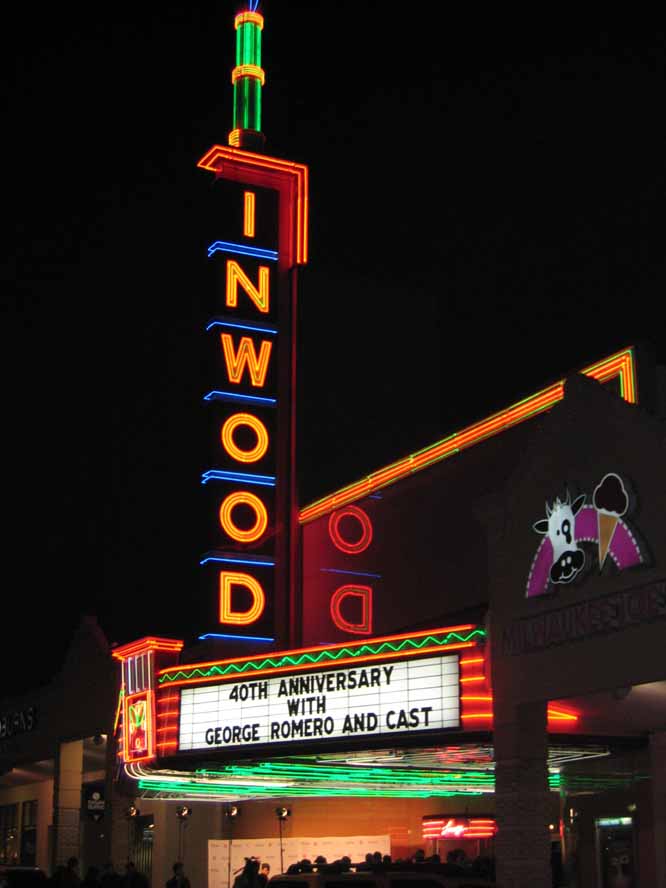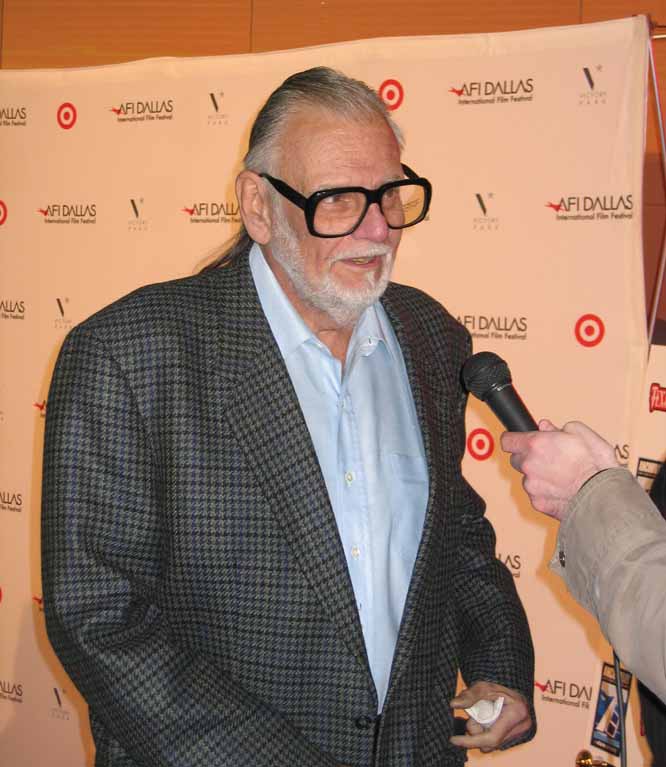 Grapevine, Texas is one of numerous communities that surround the gargantuan Dallas/Ft Worth International Airport. They exist in a symbiotic relationship; the airport brings thousands of short-stay passengers into the area each day, and the communities provide hotels, restaurants, and a preponderance of the writ-large shopping experience that one would expect from Texas. While there isn’t much in the way of specific character to the area (a trait that large airports rarely inspire), sometimes people bring their own – and that’s precisely what happened at the Texas Frightmare Weekend. The large scale horror convention is a relatively recent phenomenon, gaining steadily in popularity in larger cities on the East and West coast for the last few decades. And while in terms of size and attendance, the TFW is still the little brother to the Chiller and Fangoria cons – it’s also free of many of their pitfalls.
Grapevine, Texas is one of numerous communities that surround the gargantuan Dallas/Ft Worth International Airport. They exist in a symbiotic relationship; the airport brings thousands of short-stay passengers into the area each day, and the communities provide hotels, restaurants, and a preponderance of the writ-large shopping experience that one would expect from Texas. While there isn’t much in the way of specific character to the area (a trait that large airports rarely inspire), sometimes people bring their own – and that’s precisely what happened at the Texas Frightmare Weekend. The large scale horror convention is a relatively recent phenomenon, gaining steadily in popularity in larger cities on the East and West coast for the last few decades. And while in terms of size and attendance, the TFW is still the little brother to the Chiller and Fangoria cons – it’s also free of many of their pitfalls.
The TFW kicked off in earnest on Thursday, Feb 21st with a 40th anniversary screening of a film that, for many people, represents ground zero for the modern horror film – NIGHT OF THE LIVING DEAD. Presented in conjunction with AFI Dallasat the Inwood theater; the TFW gathered much of the original cast together, including Judith O’Dea (Barbara), Russ Streiner (Johnny), Bill Hinzman, (1st graveyard zombie), George Kosana (the Sheriff, whose line “They’re dead, there…all messed up” ignited a deafening audience reaction), Kyra Schon (Karen), co-writer John Russo, and, of course, George A Romero. Amazingly, Marilyn Eastman (Helen), unable to attend the screening after injuring her ribs in a bad fall, actually made the rest of the convention from a wheelchair!
The Inwood has been part of the Landmark Theaters chain since 1988, and along with sister theater, the Magnolia, provide Dallas with an enviable art-house experience. Though the strip mall that houses it will set few hearts aflutter, once under the gleaming marquee you feel like whoever runs the joint is there for the same reason you are. Remaining non-believers (and sober correspondents) should be set right by the Inwood Lounge located in the theater lobby. Why more theaters don’t follow this example is puzzling – any seat that isn’t spinning is a good one.
NIGHT OF THE LIVING DEAD has been brining in American pop-culture for 4 decades; few horror film have soaked up as much allegorical encumbrance, and fewer still are able to bear up under the scrutiny. Romero has never said that the casting of African-American Duane Jones was anything other than a case of ‘right man, right part’, but color blind casting was a rare bird in 1968, and even popular stars like Sidney Poitier rarely found roles where he was free from embodying the noble suffering of his race at every turn. After all, a black actor in a leading role in a motion picture had to mean something, right? And what of the zombies themselves? What dark aspect of our society does the lurching army of the undead represent? The redneck zombie-hunting parties? (well, that one isn’t too hard…)
NIGHT was made in 1968, unquestionably one of the more turbulent years in our history. With an unpopular war raging abroad, assassinations taking the lives of popular, progressive leaders, and rampant student protests tearing up both college campuses and city streets – could it really be called just a horror film? Thankfully, there is no single answer; NIGHT is teeming with political meaning – all you have to do is lightly scratch the surface. One could argue that the ultimate fate of Duane Jones’ character speaks far more eloquently on the (then) current state of race relations than other, more meaningful films (GUESS WHO’S COMING TO DINNER, long considered the ne plus ultra of late ’60s liberal film-making, now plays painfully stilted).
But most importantly, NIGHT is still a gangbusters horror film. The B&W cinematography perfectly captures the textures of a nightmare – compare this to the dreamy, albeit rambling tone of CARNIVAL OF SOULS, a film we have yet to remain awake through a complete run of (current record – 40min!). And unlike the vast majority of films in the genre, the acting is uniformly good. Low budget horror films are much like life rafts in a storm; all it takes is for one performer – lead or supporting – whose reach exceeds their grasp and everyone goes into the drink. Duane Jones (whose CV prior to NIGHT is non-existent) in particular provides immeasurable gravitas to a film that rarely stops to provide its characters with back story or motivation.
The 40th Anniversary print that is currently making the rounds looks little better than one of Romero’s re-animated corpses; many fans of the film are still surprised to learn that NIGHT was indeed shot on 35mm film. After the Walter Reade Organization filed to copyright the film (an error which likely cost them far more in revenue over the years than Romero) it fell into the public domain. Since the dawn of the home video age in the early 80s, bargain bins around the world have been filled with inferior copies of the film, as there was no need to pay royalties. It wasn’t until 1995, when Elite Entertainment undertook a painstaking restoration of the film for a laserdisc release, that an acceptable edition of the film made it into the hands of the public – and what they produced was nothing short of a revelation. Nearly 3 decades of neglect was wiped away, allowing fans who hadn’t even been born in 1968 the chance to see the film as originally intended.
This restoration, however, was of the video master only; restoring a 35mm print is another (considerably more expensive) matter entirely. The contrast of the AFI print was poor, and much fine detail has been lost to time. The soundtrack pops and sizzles like a burning breakfast, and there are enough frame dropouts to constitute a second feature – and none of it mattered one blessed bit. While some films have trouble surviving a sub-par presentation, NIGHT almost seems to thrive on it; the flickering, unstable image plays like an extended newsreel clip of some narrowly avoided apocalyptic event. Romero’s future installments to his zombie oeuvre were far slicker (and in the case of 1978’s DAWN OF THE DEAD, arguably better) but none pack NIGHT’s raw, rough punch. The only demonstrable glitch was the in the projection: NIGHT was photographed in the Academy Ratio of 1.37 and has been correctly presented ‘flat’ (without letterboxing bars) on all home video releases. For some reason, the projectionist chose to frame the film for 1.85 and cut off significant portions of the top and bottom of the screen. I didn’t hear anyone else mention it, but anyone familiar with the film must have noticed the cramped compositions forced onto it. Romero, who has probably seen the film plenty of times, left before the screening began – but it was strange (and embarrassing) for this to happen under the auspices of the AFI.
 Romero and his cast took the stage for a Q&A that was rather surprisingly hosted by fellow Frightmare guest Malcolm McDowell (McDowell was certainly game, but it was obvious that he had never seen the film before and was fulfilling pre-arranged convention duties). They discussed their company’s humble beginnings in Pittsburgh, the initial hostile reaction to the film – and a story I’ve not heard before: while driving to NYC with Russ Streiner to meet with the Walter Reade people, the news of Martin Luther King’s assassination broke on the radio. Romero sheepishly confessed that now they might “really have something” with the casting of Jones. It was a great evening, and a wonderful kickoff to the weekend.
Romero and his cast took the stage for a Q&A that was rather surprisingly hosted by fellow Frightmare guest Malcolm McDowell (McDowell was certainly game, but it was obvious that he had never seen the film before and was fulfilling pre-arranged convention duties). They discussed their company’s humble beginnings in Pittsburgh, the initial hostile reaction to the film – and a story I’ve not heard before: while driving to NYC with Russ Streiner to meet with the Walter Reade people, the news of Martin Luther King’s assassination broke on the radio. Romero sheepishly confessed that now they might “really have something” with the casting of Jones. It was a great evening, and a wonderful kickoff to the weekend.
[serialposts]
One Reply to “Texas Frightmare Weekend: "Night of the Living Dead" 40th Anniversary Screening”